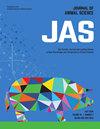Prediction of Pellet Durability Index (PDI) in a Commercial Feed Mill Using Multiple Linear Regression with Variable Selection and Dimensionality Reduction
IF 2.7
2区 农林科学
Q1 AGRICULTURE, DAIRY & ANIMAL SCIENCE
引用次数: 0
Abstract
Pellet quality, measured as Pellet Durability Index (PDI), is an important key performance indicator (KPI) for commercial feed manufacturing, as it can impact both mill efficiency and downstream performance of animals fed the manufactured diets. However, it is an ongoing challenge for the feed industry to control pellet quality, due to the complexity of feed manufacturing and the large number of variables influencing the process. Previous studies have explored prediction of pellet quality using either simple empirical models with a few variables or machine learning models with many variables. The objective of the current study was to develop statistical regression models to predict PDI, and to describe the relationship between pellet quality and 55 available variables based on a dataset with 2691 observations collected from a commercial feed mill. In the current study, the response variable (PDI) was transformed using the Box-Cox approach into the transformed response variable (tPDI), that was more normally distributed. Three multiple regression models were developed based on subsets of variables processed by variable selection and dimensionality reduction methods: Forward Selection, Principal Component Analysis, and Partial Least Squares. The results indicated that Model 1 (Forward Selection with manual removal of sparse variables), built on 9 variables, performed better than the other two models. It exhibited consistent model prediction performance on the training data and testing data, in terms of MAE (1.93 ± 0.063 versus 1.96), RMSPE (2.45 ± 0.079 versus 2.45), and CCC (0.549 ± 0.0273 versus 0.550), with a better prediction precision based on the fit plot. Expanding Temperature (℃), Fat Content (%), and ADF Content (%), and Indoor Humidity (Pelletizer) (%) were identified as more influential than other variables on the transformed response variable (tPDI) in Model 1, based on a behavior analysis. The models developed in the current study can be helpful to feed mills for predicting and comprehending the effect of a number of commonly measured variables on pellet quality in the commercial setting.求助全文
约1分钟内获得全文
求助全文
来源期刊

Journal of animal science
农林科学-奶制品与动物科学
CiteScore
4.80
自引率
12.10%
发文量
1589
审稿时长
3 months
期刊介绍:
The Journal of Animal Science (JAS) is the premier journal for animal science and serves as the leading source of new knowledge and perspective in this area. JAS publishes more than 500 fully reviewed research articles, invited reviews, technical notes, and letters to the editor each year.
Articles published in JAS encompass a broad range of research topics in animal production and fundamental aspects of genetics, nutrition, physiology, and preparation and utilization of animal products. Articles typically report research with beef cattle, companion animals, goats, horses, pigs, and sheep; however, studies involving other farm animals, aquatic and wildlife species, and laboratory animal species that address fundamental questions related to livestock and companion animal biology will be considered for publication.
 求助内容:
求助内容: 应助结果提醒方式:
应助结果提醒方式:


